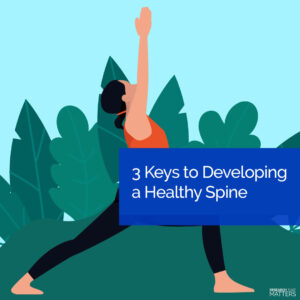section-02280fe
3 Keys to Developing a Healthy Spine
 Bottom Line:
Bottom Line:
Developing a healthy spine begins by understanding the three keys of strength, flexibility, and posture. Strength, flexibility, and improving your posture will go a long way towards reducing pain and improving your spine’s function.
Your spine is made up of bones (vertebrae), and spinal discs that separate each bone. If you look at someone from the side, you’ll notice that the vertebrae and discs create three distinct curves: the neck (cervical), mid-back (thoracic), and low back (lumbar). What you may not realize is that you began your life with a single curve, and the others developed as you began to crawl and walk as a child.
Why it Matters:
As a baby, you had a single c-shaped curve – perfect for optimizing growth and development in the womb. However, once you began to lift your head, your cervical (neck) curve began to develop. Not too much after that, your low back (lumbar) curve formed as you started to take your first steps and walk upright.
The development of these curves is critical to posture as an adolescent and adult, and there are three key factors that support the development healthy spinal curves:
- Strength: Strong core, shoulder, and leg muscles are essential to providing the proper support for your spine.
- Flexibility: Flexibility is necessary to maintain a full range of motion, which reduces your risk of injury.
- Posture: Strength and flexibility will help ease the stress on your back, as will focusing on the dynamics of your posture and being sure to frequently changing positions throughout the day.
Next Steps:
Developing a healthy spine starts when we’re young, and we all know the habits and actions we take today will affect our quality of life for years to come. Set an example and encourage your children to stay active, keep an eye on their posture, and promote activities that strengthen their spine to help support the development of great posture, and a possible reduction in their likelihood of experiencing back pain.
Science Source(s):
Three Steps to Build a Better Back. Harvard Health Publishing. 2015.
section-3845968
E-Learning at Home? It’s Time to Look Up!
 Bottom Line:
Bottom Line:
As students worldwide return to school, it appears as though many will be e-learning for hours each day on their digital devices. While our devices can be fantastic tools for entertainment and education, the postural effects are something all parents should be aware of. For many students, e-learning may increase in neck, mid-back, and low back pain.
Why it Matters:
Spending 6 or more hours each day on a digital device can profoundly affect your mental, social, and physical health. Prolonged periods looking at a phone, tablet, or computer can result in “Tech Neck Syndrome.” This forward head posture can place a tremendous amount of stress on the neck (cervical spine) and lead to headaches, back pain, neck pain, and more.
Did you know…
- It’s estimated that 50.3% of school-aged children present with posture disorders.
- A surprising 41.6% of children experience back pain from prolonged sitting.
- Low back pain is the 3rd most common form of pain that interferes with schoolwork.
Next Steps:
Making it a habit to look up (literally!) throughout the day is a great first step in significantly reducing the effects of “Tech Neck”.
Try this: pull your chin back, open your arms out wide, and look up to the ceiling and stretch at least every 60 minutes to help reset your posture and body position.
Remember, if your child is spending every day at their computer, schedule a check-up with us to provide you with a full posture and movement-based assessment so we can identify any potential issues and work together to come up with a plan to reduce their chance of dealing with the effects of “Tech Neck Syndrome.”
Science Source(s):
section-8702f34
3 Ways to Lighten the Load of Your Child’s Backpack
 Bottom Line:
Bottom Line:
Does your child’s backpack feel like a 50-pound bag of rocks? You may have noticed that your child struggles to get it on in the morning or may even need help to pull the straps together enough to click the buckle. What’s more, researchers and healthcare organizations are growing more concerned about the effects of this extra weight on your child’s developing spine.
Why it Matters:
It’s estimated that over 60% of children routinely carry backpacks that weigh more than 10% of their body weight. For some children, that may mean carrying a backpack nearly identical to their own body weight!
This is a big deal because researchers have found that carrying heavy backpacks increases the risk of back pain in children by a whopping 50%.
The good news? You’ve got their back.
- Ergonomics: Select an appropriately sized backpack. It shouldn’t be wider than their torso or sit more than 4 inches below their waist.
- Fit: Use both shoulder straps to balance the weight and ensure that the are snug so the backpack doesn’t hang low.
- Packing: Teach your child to place the heaviest items towards the bottom of the backpack and use all the compartments to distribute the load.
Next Steps:
One benefit of the e-learning movement is that digital versions on the computer are replacing many heavy textbooks (though long hours of e-learning have their host of challenges, as you’ll discover next week!).
Most experts agree that a backpack shouldn’t weigh more than 10% of the child’s body weight. Backpacks that are too heavy can lead to back or neck pain, as well as poor posture. If your child has developed poor posture or neck/back pain, let us know. We’d be happy to evaluate their posture and movement to correct any concerns before they become a problem.
Science Source(s):
Backpack Safety: It’s time to lighten the load. National Safety Council. 2020.
section-1bd1ad9
Powering Your Child’s Brain with Movement
 Bottom Line:
Bottom Line:
Years ago, researchers believed that the health benefits of exercise were limited to the body. However, recent research has indicated that regular physical activity and movement can benefit both the body and brain. We’re seeing that movement supplies the brain cells with oxygen, promotes the production of new cells, and aides in creating synapses (connections in the brain).
Why it Matters:
With many schools reducing physical education classes, and even more students moving towards e-learning, you want to be sure to encourage your child to exercise each day.
Movement triggers the release of many chemical substances in the brain that enhance brain function. In many ways, exercising each day is likely to make your child a better student, in many ways!
- Brain Function: Movement may protect your brain against degenerative changes.
- Stress Reduction: Exercise and movement have been shown to decrease stress and has an antidepressant effect.
- Memory: Regular exercise can help memory and thinking in both direct and indirect ways.
Next Steps:
In the past, we may have considered exercise and physical education classes to be a distraction from learning. Now we have come to understand that movement and exercise play an integral role in learning and brain function.
Daily movement and exercise are healthy for both your child’s body and brain. If your child struggles to get enough exercise due to pain or postural issues, schedule an appointment with us today. Our posture and movement assessments are designed to identify abnormal patterns, and our care can help your child feel better so that they can stay active and become the best student possible!
Science Source(s):
Learning Up Regulates Brain-derived Neurotrophic Factor Messenger RNA. BN. 2019.
The Anti-depressant Effect of Running. International Journal of Neuropsychopharmacology. 2005.
Regular Exercise Changes the Brain to Improve Memory. Harvard Health Publishing. 2014.









